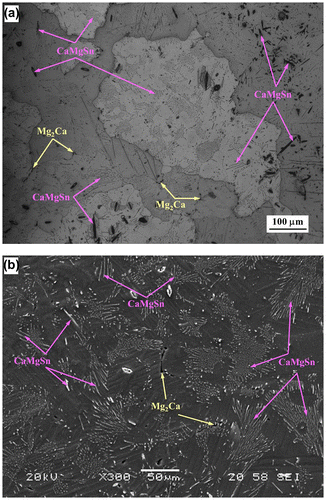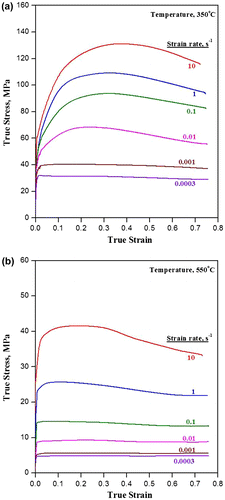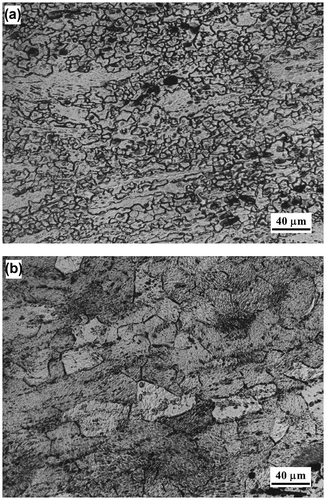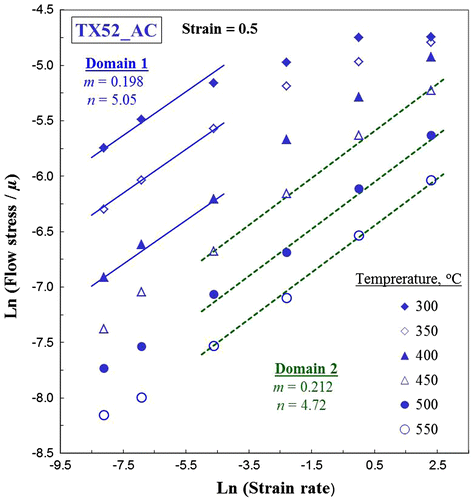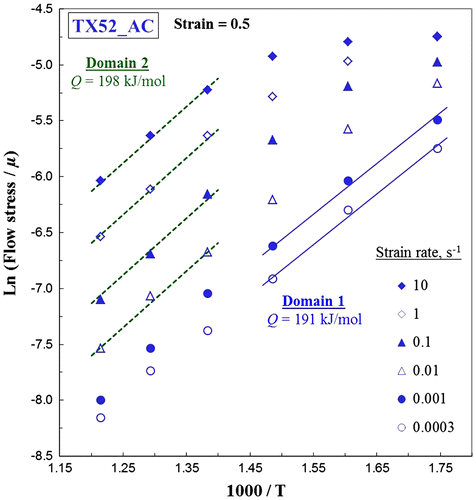 ?Mathematical formulae have been encoded as MathML and are displayed in this HTML version using MathJax in order to improve their display. Uncheck the box to turn MathJax off. This feature requires Javascript. Click on a formula to zoom.
?Mathematical formulae have been encoded as MathML and are displayed in this HTML version using MathJax in order to improve their display. Uncheck the box to turn MathJax off. This feature requires Javascript. Click on a formula to zoom.Abstract
The hot deformation behavior of TX52 has been studied with a processing map developed on the basis of its temperature and strain rate dependence of flow stress. The map exhibits two domains of dynamic recrystallization in the ranges of (1) 300–410 °C/0.0003–0.003 s−1 and (2) 440–550 °C/0.02–10 s−1. Kinetic analysis gives apparent activation energy values of 191 and 198 kJ/mol in Domains 1 and 2, respectively. These values are higher than self-diffusion in Mg signifying that substantial back stress is being generated due to the large volume fraction of intermetallic particles in the matrix. In Domain 1, basal + prismatic slip occurs with recovery by climb, while at higher temperatures (Domain 2) second-order pyramidal slip occurs with simultaneous softening by cross-slip. Domain 2 is recommended for maximizing workability and Domain 1 for finishing steps to achieve finer grain size in the final product.
1. Introduction
Magnesium alloys are in demand in the automobile industry which requires lightweight materials to achieve fuel economy and emission control (Hu, Yu, Li, & Allison, Citation2003). The Mg–Sn–Ca system is being investigated for developing wrought alloys with good corrosion and creep resistance (Abu Leil, Rao, Hort, & Kainer, Citation2006). In this system, the addition of Sn to Mg forms a solid solution that enhances corrosion resistance and Ca to Mg forms an intermetallic phase to improve creep resistance (Hort, Huang, Abu Leil, Rao, & Kainer, Citation2011).
The addition of Sn to Mg–6Al–4Zn alloy refines dendrite grains that benefit strength and ductility (Dong, Fu, Wang, & Yang, Citation2013). Mg2Sn phase forms largely at the grain boundaries when Sn is added to Mg–4Zn and Mg–6Zn–1Mn alloys (Qi, Zhang, Zhang, & Xu, Citation2014; Wei, Zhu, Hodgson, & Gao, Citation2013), and their strength improves at the expense of elongation. Kim, Kim, Yu, Choi, and Son (Citation2014) observed the formation of MgLi2Sn phase and improved tensile strength in Mg–Al–Sn–Li alloys. The addition of Sn to AZ91 alloy (Mahmudi & Moeendarbari, Citation2013) and Mg–5Al–3Ca alloy (Terbush, Chen, Jones, & Pollock, Citation2012) enhances the creep resistance. Improved tensile strength and creep resistance have been reported by Yang, Guo, Li, Duan, and Zhang (Citation2013) when Sn is added to Mg–3.8Zn–2.2Ca alloy.
The addition of Ca enhances the creep strength of Mg–4Al–2Sn cast alloy due to the formation of thermally stable CaMgSn phase (Kim, Jo, Lee, Park, & Park, Citation2012). In Mg–Zn–Ca alloys, development of textures during rolling is composition dependent, with basal poles split in the rolling or transverse directions (Kim et al., Citation2013). Nayyeri, Ganjkhanlou, Kolahi, and Jamil (Citation2014) observed significant changes in the texture of Mg–4Al–2Sn–1RE cast alloy upon the addition of Ca which modifies the composition and morphology of intermetallic phases from acicular shape to fine feather shape. AZ31 alloys with Ca have shown improvement in high temperature strength and dynamic recrystallization behavior (Suresh, Rao, Prasad, Hort, & Kainer, Citation2013, Citation2014b). Hradilová, Montheillet, Fraczkiewicz, Desrayaud, and Lejček (Citation2013) also reported that Ca promoted the recrystallization behavior of Mg–Zn alloy during hot deformation process. The Ca-containing Mg–Al–Ba cast alloy exhibited (Rao et al., Citation2013) fine grain size and high creep resistance.
The effect of Sn/Ca ratio on the intermetallic phases present in the microstructure has been analyzed in detail (Kim et al., Citation2008; Kozlov et al., Citation2008; Nayyeri & Mahmudi, Citation2010). When the ratio is higher, mostly CaMgSn phase forms in the matrix. However, at lower Sn/Ca ratios, Mg2Ca additionally forms at the grain boundaries. Hot workability studies on a series of TX alloys, Mg–2Sn–2Ca (TX22) (Rao, Prasad, Suresh, Hort, & Kainer, Citation2012), Mg–3Sn–2Ca (TX32) (Dharmendra, Rao, Prasad, Hort, & Kainer, Citation2013), and Mg–4Sn–2Ca (TX42) (Suresh, Rao, Prasad, Hort, & Kainer, Citation2014a) have been conducted using processing maps and optimum workability domains have been identified for industrial applications. The aim of the present investigation is to evaluate the hot working behavior of TX52 (Mg–5Sn–2Ca) alloy, which has a higher Sn/Ca ratio (2.5) than the alloys mentioned above. The ratio influences the intermetallic phases that form in the microstructure and will have an effect on the hot workability and mechanisms of hot deformation.
The hot deformation behavior is analyzed using the kinetic analysis and processing maps. The former one is based on the standard Arrhenius kinetic rate equation relating the flow stress (σ) to strain rate () and temperature (T), given by Jonas, Sellars, and Tegart (Citation1969):
(1)
(1)
where A = constant, n = stress exponent, Q = activation energy, and R = gas constant. The activation parameters n and Q may be used to identify the rate-controlling mechanisms. The technique of processing map is based on the dynamic materials model, and the principles are described earlier (Prasad, Citation2003; Prasad & Sasidhara, Citation1997; Prasad & Seshacharyulu, Citation1998). In this model, the work-piece undergoing hot deformation is considered to be a dissipator of power, and the strain rate sensitivity (m) of flow stress is the factor that partitions power between deformation heat and microstructural changes. The efficiency of power dissipation (η) occurring through microstructural changes during deformation is obtained (Prasad, Citation2003) by comparing the non-linear power dissipation occurring instantaneously in the work-piece with that of a linear dissipator for which the m value is unity, following the equation:(2)
(2)
The variation of efficiency of power dissipation with temperature and strain rate represents a power dissipation map, and is generally represented as an iso-efficiency contour map. Further, the extremum principles of irreversible thermodynamics as applied to continuum mechanics of large plastic flow (Ziegler, Citation1965) are explored to define a criterion for the onset of flow instability given by the equation for the instability parameter ξ():
(3)
(3)
An instability map may be developed based on the variation of the instability parameter as a function of temperature and strain rate, in which regimes of instability are delineated where ξ is negative. A superimposition of the instability map on the power dissipation map gives a processing map. This reveals domains in which efficiency contours converge towards a peak efficiency where individual microstructural processes occur and the limiting conditions of flow instability regimes bounded by a contour for ξ = 0. Such a processing map helps in identifying temperature–strain rate windows (domains) for hot working where the intrinsic workability of the material is maximum (e.g. dynamic recrystallization (DRX) or superplasticity) and also in avoiding the regimes of flow instabilities (e.g. adiabatic shear bands or flow localization).
2. Experimental
The TX52 alloy used in the current investigation was prepared using estimated quantities of elemental metals having purities of 99.98% Mg, 99.96% Sn, and 98.5% Ca to obtain an alloy with the composition (wt.%) of 5% Sn–2% Ca and 93% Mg. The metals were melted with the aid of Ar + SF6 gas cover. The melt was poured at a temperature of 720 °C into a preheated permanent steel mold to obtain a cast billet of 100 mm diameter and 350 mm height. Cylindrical specimens of 10 mm diameter and 15 mm height were fabricated from a slice of the billet. The specimens were deformed up to a true strain of about .75 in the temperature range of 300–550 °C and strain rate range of .0003–10 s−1 (6 × 6 experimental matrix) using a computer-controlled servo-hydraulic test machine manufactured by Dartec, UK Ltd. The true stress–true strain curves were obtained from the measured load–stroke data using standard equations. The flow stress values were corrected for the relevant experimental data points when the adiabatic temperature rise is significant. Details of the experimental setup and testing procedure have been described earlier by Rao et al. (Citation2012). All the specimens were sectioned at the center parallel to the compression axis and the cut surface was used for the metallographic examinations. Acetic picral solution was used for etching the cut sections of the specimen, and their microstructure features were captured using an optical microscope.
3. Results and discussion
3.1. Cast microstructures
The starting microstructure of as-cast TX52 alloy is shown in Figure , which exhibits a large volume of CaMgSn intermetallic particles in the matrix and a smaller amount of Mg2Ca phase at the grain boundaries. The average grain diameter was about 500 μm. The existence of the above two phases has been confirmed by thermodynamic modeling, as well as microstructural studies (Kim et al., Citation2008; Kozlov et al., Citation2008; Nayyeri & Mahmudi, Citation2010).
3.2. Stress–strain behavior
The typical true stress–true strain curves obtained at 350 and 550 °C (low and high temperatures) at different strain rates are shown in Figure . At a lower temperature of 350 °C (Figure (a)), the flow stress increases with strain to reach a maximum value in the strain range of .2–.4 depending on the strain rate. At higher strain rates of .01–10 s−1, the flow stress decreases from the peak value with increase in strain rate. A steady-state deformation occurred at lower strain rates of .0003 and .001 s−1. At a higher temperature of 550 °C (Figure (b)), the flow softening is significant only at 1 and 10 s−1, and decreased with decreasing strain rate, and the flow curves approached and became near-steady state at strain rates of .1 s−1 and lower.
3.3. Processing map and microstructures
The processing map for as-cast TX52 alloy obtained at a strain of .5 (nearly steady state) is shown in Figure , which exhibits two domains and splits diagonally at about 425 °C:
Domain 1 occurs in the temperature range of 300–410 °C and strain rate range of .0003–.003 s−1 with a peak efficiency of about 36% occurring at 350 °C and .0003 s−1.
Domain 2 occurs in the temperature range of 440–550 °C and strain rate range of .02–10 s−1 with a peak efficiency of about 36% occurring at 500 °C and 10 s−1.
Figure 3. Processing map of Mg–5Sn–2Ca at a strain of .5. The numbers against the contours indicate efficiency of power dissipation in percent and the dark line separates the stable and unstable regions.
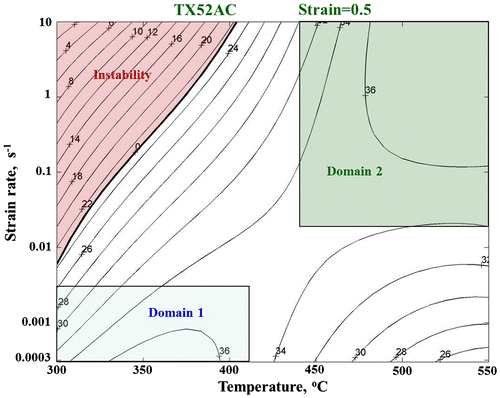
At lower temperature and higher strain rates, the specimens exhibited adiabatic shear band formation in the flow instability region and resulted in shear fracture at high strain rates.
The microstructure obtained on specimens deformed near the peak efficiency conditions in Domain 1 (350 °C/.0003 s−1) and Domain 2 (550 °C/10 s−1) is shown in Figure (a) and (b). The microstructures show that DRX is occurring in these two domains and the average grain diameter is 15 μm in Domain 1 and 40 μm in Domain 2. Thus, DRX has resulted in considerable grain refinement compared with the grain size in the as-cast alloy (500 μm) in both the domains. The microstructure of the specimen deformed in the flow instability regimes (300 °C/10 s−1 and 300 °C/.1 s−1) is shown in Figure . The material exhibited adiabatic shear band formation in Figure (a), and the flow localization as exposed in Figure (b).
3.4. Kinetic analysis
The apparent activation parameters may be evaluated using the standard kinetic rate equation (Equation (Equation1(1)
(1) )), which is valid in each of the good workability domains. This is done with the help of flow stress data selected at a true strain of .5 (represents near-steady state). The variation of flow stress as a function of ln (strain rate) is shown in Figure . In Domain 1, the stress exponent value is 5.05, and it is 4.72 in Domain 2. The Arrhenius plot showing the variation of ln (flow stress/μ) with (1/T), where μ is the shear modulus, is shown in Figure . In this plot, it may be noted that the data points corresponding to Domain 1 (300, 350, and 400 °C at the two lowest strain rates) fall on straight line fits, with about the same slope while those at higher strain rates do not fit since they are in the flow instability regime. Similarly, the data points from Domain 2 obey straight line fits with same slope, indicating that the kinetic rate equation is obeyed within the domain. The estimated apparent activation energy is 191 kJ/mol for Domain 1, and it is 198 kJ/mol for Domain 2. These values are obviously higher than the self-diffusion in pure magnesium (135 kJ/mol) (Flynn, Mote, & Dorn, Citation1961), signifying that the back stress caused by CaMgSn intermetallic particles in the matrix plays a vital role.
3.5. Mechanisms of hot deformation
The rate-controlling mechanisms may be different in both the DRX Domains 1 and 2. In Domain 1, where the temperatures are somewhat lower, basal slip and prismatic slip largely contribute to the deformation (Ziegler, Citation1965) and the softening mechanism will be climb of dislocations controlled by self-diffusion (Flynn et al., Citation1961). This process being slower calls for lower strain rates. If faster speeds are used while processing in the first domain, the alloys may exhibit instability regime leading to flow localization of microstructure. High activation energy is essential for DRX to overcome the back stress generated by hard CaMgSn particles present in the matrix. In Domain 2, second-order pyramidal slip occurs extensively at higher temperatures (Frost & Ashby, Citation1982) of about 440 °C, leading to the cross-slip as softening mechanism (Obara, Yoshinga, & Morozumi, Citation1973). The stacking fault energy is high on pyramidal slip systems due to the presence of multiple intersecting slip planes (Koike et al., Citation2003; Morris et al., Citation1977). In this domain, processing of materials is faster than the first domain, owing to the faster occurrence of DRX by cross-slip mechanism.
The presence of Mg2Ca at grain boundaries and CaMgSn in matrix results in the following effects. In Domain 1, the grain boundary does not have a direct influence as basal + prismatic slip happens along with the climb of dislocations. However, in Domain 2, Mg2Ca phase prevents grain boundary sliding and strengthens the materials against high-temperature intercrystalline fracture. Pyramidal slip and associated cross-slip within the grain volume increases with temperatures of up to 550 °C, which in turn controls the high temperature workability of the domain.
4. Conclusions
Hot deformation behavior of as-cast Mg–5Sn–2Ca alloy in the temperature and strain rate range ranges of 300–550 °C and .0003–10 s−1 were investigated with the help of processing maps and kinetic analysis. The following conclusions are drawn:
The processing map revealed two dynamic recrystallization domains for hot working the alloy: (1) 300–410 °C/.0003–.003 s−1 and (2) 440–550 °C/.02–10 s−1.
The estimated apparent activation energy values are 191 kJ/mol in Domain 1 and 198 kJ/mol in Domain 2. These two values are higher than self-diffusion in Mg (135 kJ/mol), signifying that substantial back stress is being generated due to the large volume fraction of intermetallic particles (CaMgSn) present in the matrix.
The mechanism of DRX involves basal + prismatic slip with recovery by climb in Domain 1, and second-order pyramidal slip with softening by cross-slip in Domain 2.
For maximizing workability of TX52, bulk working may be done in Domain 2, and finish working may be done in Domain 1 to obtain finer grain size in the final product.
Acknowledgments
This research work has been fully supported by a research grant (General Research Fund, Project #114809) from the Research Grants Council of the Hong Kong Special Administrative Region, China. The technical assistance of Mr C.H. Yuen for conducting the hot deformation tests is acknowledged.
References
- Abu Leil, T., Rao, K. P., Hort, N., & Kainer, K. U. (2006). Corrosion behavior and microstructure of a broad range of Mg–Sn–X alloys. In A. A. Luo, N. R. Neelameggham, & R. S. Beals (Eds.), Magnesium technology 2006 (pp. 281–286). Warrendale, PA: The Minerals, Metals and Materials Society.
- Dharmendra, C., Rao, K. P., Prasad, Y. V. R. K., Hort, N., & Kainer, K. U. (2013). Hot workability analysis with processing map and texture characteristics of as-cast TX32 magnesium alloy. Journal of Materials Science, 48, 5236–5246.10.1007/s10853-013-7314-9
- Dong, X., Fu, J., Wang, J., & Yang, Y. (2013). Microstructure and tensile properties of as-cast and as-aged Mg–6Al–4Zn alloys with Sn addition. Materials and Design, 51, 564–567.
- Flynn, P. W., Mote, J., & Dorn, J. E. (1961). On the thermally activated mechanism of prismatic slip in magnesium single crystals. Transactions of Metallurgical Society of AIME, 221, 1148–1154.
- Frost, H. J., & Ashby, M. F. (1982). Deformation-mechanism maps: The plasticity and creep of metals and ceramics (p. 44). Oxford: Pergamon Press.
- Hort, N., Huang, Y. D., Abu Leil, T., Rao, K. P., & Kainer, K. U. (2011). Properties and processing of magnesium-tin-calcium alloys. Kovove Materialia, 49, 163–177.
- Hradilová, M., Montheillet, F., Fraczkiewicz, A., Desrayaud, C., & Lejček, P. (2013). Effect of Ca-addition on dynamic recrystallization of Mg–Zn alloy during hot deformation. Materials Science and Engineering A, 580, 217–226.10.1016/j.msea.2013.05.054
- Hu, H., Yu, A., Li, N., & Allison, J. E. (2003). Potential magnesium alloys for high temperature die cast automotive applications: A review. Materials and Manufacturing Processes, 18, 687–717.10.1081/AMP-120024970
- Jonas, J. J., Sellars, C. M., & Tegart, W. J. McG. (1969). Strength and structure under hot-working conditions. International Materials Reviews, 14, 1–24.10.1179/095066069790138056
- Kim, B.-H., Jo, S.-M., Lee, Y.-C., Park, Y.-H., & Park, I.-K. (2012). Microstructure, tensile properties and creep behavior of Mg–4Al–2Sn containing Ca alloy produced by different casting technologies. Materials Science and Engineering A, 535, 40–47.10.1016/j.msea.2011.12.038
- Kim, D. H., Lee, J. Y., Lim, H. K., Kyeong, J. S., Kim, W. T., & Kim, D. H. (2008). The effect of microstructure evolution on the elevated temperature mechanical properties in Mg–Sn–Ca system. Materials Transactions, 49, 2405–2413.10.2320/matertrans.MER2008140
- Kim, D.-W., Suh, B.-C., Shim, M.-S., Bae, J. H., Kim, D. H., & Kim, N. J. (2013). Texture evolution in Mg–Zn–Ca alloy sheets. Metallurgical and Materials Transactions A, 44, 2950–2961.10.1007/s11661-013-1674-2
- Kim, Y.-H., Kim, J.-H., Yu, H.-S., Choi, J.-W., & Son, H.-T. (2014). Microstructure and mechanical properties of Mg–xLi–3Al–1Sn–0.4Mn alloys (x = 5, 8 and 11 wt%). Journal of Alloys and Compounds, 583, 15–20.10.1016/j.jallcom.2013.08.154
- Koike, J., Kobayashi, T., Mukai, T., Watanabe, H., Suzuki, M., Maruyama, K., & Higashi, K. (2003). The activity of non-basal slip systems and dynamic recovery at room temperature in fine-grained AZ31B magnesium alloys. Acta Materialia, 51, 2055–2065.10.1016/S1359-6454(03)00005-3
- Kozlov, A., Ohno, M., Abu Leil, T., Hort, N., Kainer, K. U., & Schmid-Fetzer, R. (2008). Phase equilibria, thermodynamics and solidification microstructures of Mg–Sn–Ca alloys, part 2: Prediction of phase formation in Mg-rich Mg–Sn–Ca cast alloys. Intermetallics, 16, 316–321.10.1016/j.intermet.2007.10.011
- Mahmudi, R., & Moeendarbari, S. (2013). Effects of Sn additions on the microstructure and impression creep behaviour of AZ91 magnesiumalloy. Materials Science and Engineering A, 566, 30–39.10.1016/j.msea.2012.12.076
- Morris, J. R., Scharff, J., Ho, K. M., Turner, D. E., Ye, Y. Y., & Yoo, M. H. (1997). Prediction of a {1122} hcp stacking fault using a modified generalized stacking-fault calculation. Philosophical Magazine A, 76, 1065–1077.10.1080/01418619708200015
- Nayyeri, G., & Mahmudi, R. (2010). The microstructure and impression creep behavior of cast, Mg–5Sn–xCa alloys. Materials Science and Engineering A, 527, 2087–2098.10.1016/j.msea.2009.11.053
- Nayyeri, M. J., Ganjkhanlou, Y., Kolahi, A., & Jamil, A. M. (2014). Effect of Ca and rare earth additions on the texture, microhardness, microstructure and structural properties of as-cast Mg–4Al–2Sn alloys. Transactions Indian Institute of Metals. doi:10.1007/s12666-013-0365-4
- Obara, T., Yoshinga, H., & Morozumi, S. (1973). {112̄2}〈1123〉Slip system in magnesium. Acta Metallurgica, 21, 845–853.10.1016/0001-6160(73)90141-7
- Prasad, Y. V. R. K. (2003). Processing maps: A status report. Journal of Materials Engineering and Performance, 12, 638–645.10.1361/105994903322692420
- Prasad, Y. V. R. K., & Sasidhara, S. (1997). Hot working guide: A compendium of processing maps. Materials Park, OH: ASM International.
- Prasad, Y. V. R. K., & Seshacharyulu, T. (1998). Modelling of hot deformation for microstructural control. International Materials Reviews, 43, 243–258.10.1179/imr.1998.43.6.243
- Qi, F., Zhang, D., Zhang, X., & Xu, X. (2014). Effect of Sn addition on the microstructure and mechanical properties of Mg–6Zn–1Mn (wt.%) alloy. Journal of Alloys and Compounds, 585, 656–666.10.1016/j.jallcom.2013.09.156
- Rao, K. P., Ip, H. Y., Suresh, K., Prasad, Y. V. R. K., Wu, C. M. L., Hort, N., & Kainer, K. U. (2013). Compressive strength and hot deformation mechanism in as-cast Mg–4Al–2Ba–2Ca (ABaX422) alloy. Philosophical Magazine, 93, 4364–4377.10.1080/14786435.2013.830202
- Rao, K. P., Prasad, Y. V. R. K., Suresh, K., Hort, N., & Kainer, K. U. (2012). Hot deformation behavior of Mg–2Sn–2Ca alloy in as-cast condition and after homogenization. Materials Science and Engineering A, 552, 444–450.10.1016/j.msea.2012.05.068
- Suresh, K., Rao, K. P., Prasad, Y. V. R. K., Hort, N., & Kainer, K. U. (2013). Effect of calcium addition on the hot working behaviour of as-cast AZ31 magnesium alloy. Materials Science and Engineering A, 588, 272–279.10.1016/j.msea.2013.09.031
- Suresh, K., Rao, K. P., Prasad, Y. V. R. K., Hort, N., & Kainer, K. U. (2014a). A study on the hot deformation behavior of cast Mg–4Sn–2Ca (TX42) alloy. JOM, 66, 322–328.10.1007/s11837-013-0820-z
- Suresh, K., Rao, K. P., Prasad, Y. V. R. K., Hort, N., & Kainer, K. U. (2014b). Study of hot forging behavior of as-cast Mg–3Al–1Zn–2Ca alloy towards optimization of its hot workability. Materials & Design, 57, 697–704.10.1016/j.matdes.2014.01.032
- Terbush, J. R., Chen, O. H., Jones, J. W., & Pollock, T. M. (2012). The dependence of creep behavior on elemental partitioning in Mg–5Al–3Ca–xSn alloys. Metallurgical and Materials Transactions A, 43, 3120–3134.10.1007/s11661-012-1158-9
- Wei, S., Zhu, T., Hodgson, M., & Gao, W. (2013). Effects of Sn addition on the microstructure and mechanical properties of as-cast, rolled and annealed Mg–4Zn alloys. Materials Science and Engineering A, 585, 139–148.10.1016/j.msea.2013.07.051
- Yang, M., Guo, T., Li, H., Duan, C., & Zhang, J. (2013). Effects of Sn addition on as-cast microstructure and mechanical properties of Mg–3.8Zn–2.2Ca magnesium alloy. Rare Metal Materials and Engineering, 42, 1541–1546.
- Ziegler, H. (1965). Some extremum principles in irreversible thermodynamics with application to continuum mechanics. In I. N. Sneddon & R. Hill (Eds.), Progress in solid mechanics (Vol. 4, pp. 91–193). New York, NY: Wiley.

